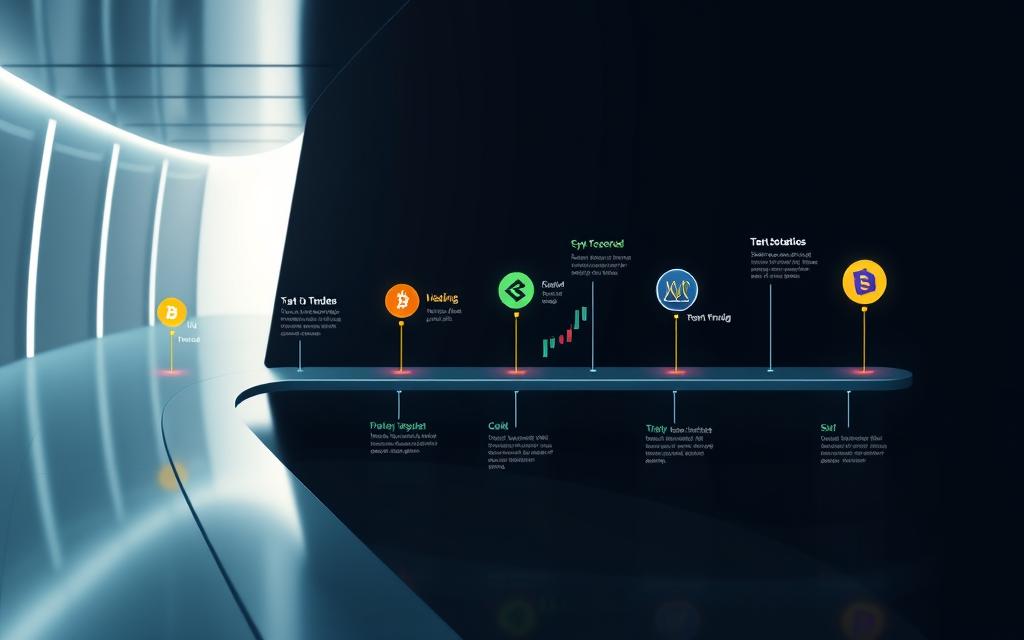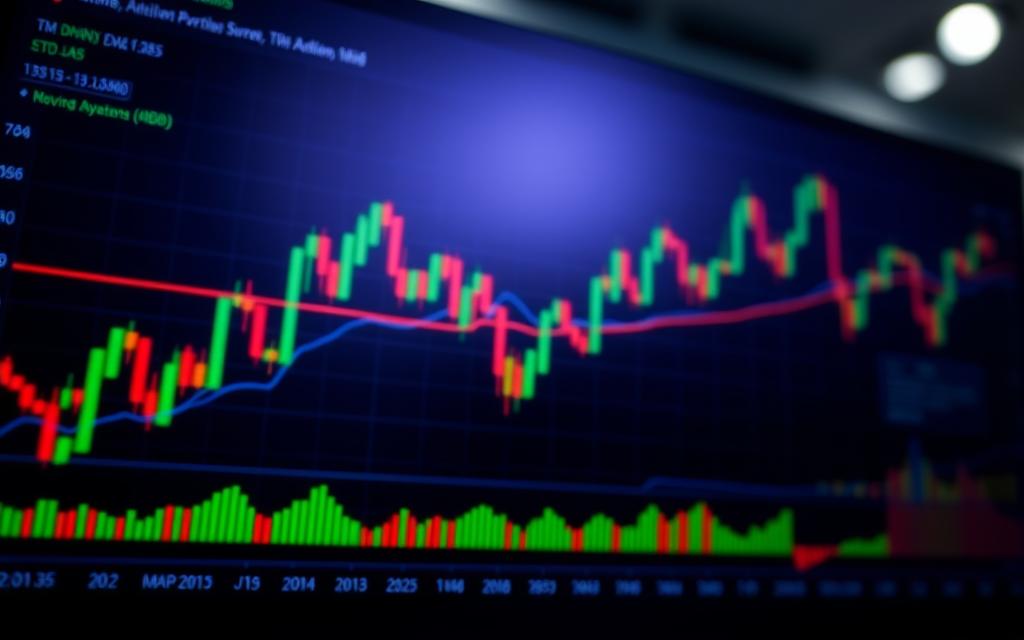Table of Contents
Cryptocurrency markets offer exciting opportunities for traders, but success requires strategy and discipline. Unlike traditional markets, digital assets trade 24/7, allowing flexibility but demanding constant attention.
Volatility in assets like Bitcoin presents both profit potential and risk. Studies show over 95% of beginners lose money, emphasizing the need for proper education. Mastering chart analysis and risk management separates successful traders from the rest.
This guide outlines a 12-step roadmap covering everything from account setup to tax compliance. Platforms like Binance provide essential tools, while demo accounts let you practice without risk. Learn more about trading cryptocurrency CFDs to expand your knowledge.
Whether you’re new to digital assets or refining your approach, understanding market mechanics proves crucial. The journey begins with education and develops through disciplined execution.
What Is Day Trading Cryptocurrency?
Digital assets have revolutionized financial markets, creating unique opportunities for active participants. Unlike traditional investments, this approach focuses on short-term price movements rather than long-term holdings.
Definition and Key Characteristics
This strategy involves opening and closing positions within a single session, typically lasting minutes to hours. Blockchain technology enables these rapid transactions without centralized intermediaries.
Key features distinguish this approach:
- Typical profit targets range between 1-5% per trade
- Most positions remain open less than six hours
- Margin requirements often reach 50% of position value
Extreme price swings create both opportunity and risk. One altcoin famously surged 4000% within 24 hours before crashing equally dramatically.
How It Differs From Traditional Markets
Stock exchanges operate limited hours, while digital asset markets never close. This constant availability demands vigilance but offers flexibility.
Other critical differences include:
- Instant settlement versus T+2 for equities
- Higher margin requirements (50% vs 25% for stocks)
- Decentralized infrastructure rather than regulated exchanges
“The market never sleeps, and neither do serious participants. This demands discipline most traditional traders never develop.”
CFD instruments allow speculation without direct asset ownership, adding another layer of complexity. A $10,000 Ethereum position might require just $5,000 in margin capital.
Pros and Cons of Day Trading Crypto
Navigating short-term price movements requires understanding key benefits and pitfalls. Digital assets offer unique advantages but demand disciplined risk management to avoid common traps.

Advantages: Profit Potential and Market Accessibility
Round-the-clock markets eliminate time restrictions, unlike traditional exchanges. Scalping strategies often yield 0.5–2% daily profit for disciplined participants.
Key benefits include:
- No Pattern Day Trader (PDT) rules restricting frequent trades
- Leverage options up to 100x on select platforms
- Lower barriers to entry compared to regulated markets
A 2022 EOS trade demonstrated 23% gains in six hours, showcasing profit opportunities during bullish trends.
Risks: Volatility and Overtrading
Bitcoin’s 20% flash crash in May 2021 highlights extreme volatility. Average daily swings of 5% dwarf forex pairs like EUR/USD (0.7%).
Critical dangers include:
- Exchange hacks (e.g., Mt. Gox’s $460M loss)
- Overtrading—experts recommend risking ≤1% per trade
- Tax complexities (IRS Form 8949 reporting)
“Emotional decisions during price swings erase months of gains. Stick to your system.”
| Market | Avg. Daily Volatility | Leverage Limits |
|---|---|---|
| Cryptocurrency | 5% | Up to 100x |
| Forex (EUR/USD) | 0.7% | 50x |
| Stocks (S&P 500) | 1.2% | 4x |
Successful participants balance aggressive tactics with safeguards like stop-loss orders. Understanding these dynamics separates sustainable strategies from reckless speculation.
Essential Tools for Crypto Day Trading
Successful digital asset traders rely on specialized platforms and analytical resources. The right combination of technology and data separates consistent performers from temporary participants.
Platforms That Power Your Strategy
Binance dominates with $76 billion daily liquidity, offering 0.1% fees for high-volume participants. Coinbase Pro provides regulatory compliance at 0.6% per transaction, while Kraken Futures supports advanced derivatives.
Key platform considerations include:
- API access for automated execution
- Cold wallet integration security
- Real-time order book depth
| Platform | Fee Structure | Daily Volume |
|---|---|---|
| Binance | 0.1% | $76B |
| Coinbase Pro | 0.6% | $8B |
| Kraken Futures | 0.02% maker | $3B |
Decoding Market Movements
TradingView’s 50+ indicators transform raw price action into actionable signals. Glassnode tracks whale movements through on-chain analytics, revealing accumulation patterns before major rallies.
Professional setups often feature:
- Quad-monitor workstations
- Low-latency fiber connections
- Python scripts for backtesting
“Charts tell stories—learn their language before risking capital.”
Protecting Your Capital
3Commas automates stop-loss orders during volatility spikes, while Cryptowatch alerts identify liquidity crunches. Experts recommend dedicating 10% of your budget to risk management tools.
Critical safeguards include:
- Smart trailing stops
- Position size calculators
- Tax lot tracking
These resources form the foundation for sustainable participation in fast-moving markets. Quality tools amplify skill—they don’t replace it.
How to Day Trade Crypto: A Beginner’s Roadmap
Entering the world of digital asset markets requires careful preparation and strategic planning. This roadmap breaks down essential steps to get started while minimizing common beginner mistakes.

Setting Up Your Trading Account
Choosing reliable exchanges forms your foundation. Binance processes verifications within 24 hours, while Coinbase often completes ID checks in minutes. These platforms provide:
- Secure wallet integration
- Real-time price alerts
- Tax documentation tools
Experts recommend beginning with a $500 minimum balance. This allows testing strategies while following the 1% risk-per-trade rule.
Choosing the Right Cryptocurrencies
Focus on assets with over $1 billion market cap and consistent 5% daily swings. Bitcoin and Ethereum should comprise 70% of your portfolio, with altcoins filling the remaining 30%.
Key selection criteria include:
- Liquidity depth (minimum $10M daily volume)
- Exchange support across major platforms
- Clear historical volatility patterns
Understanding Market Orders
Mastering order types prevents costly execution errors. Limit orders let you set exact entry points, while market orders fill immediately at current prices.
“Paper trading accounts reveal order nuances without financial risk. Practice until execution becomes instinctive.”
Stop-limit orders combine protection with precision, automatically triggering when prices hit predetermined levels. Demo platforms like Bybit simulate real market conditions for risk-free learning.
Technical Analysis Strategies for Day Traders
Mastering market movements requires decoding price patterns and trends. Charts transform raw data into actionable signals when analyzed correctly. Professional traders combine multiple indicators to confirm entry and exit points.

Candlestick Patterns and Chart Reading
Bullish engulfing patterns signal potential reversals after downtrends. These occur when a green candle completely “engulfs” the previous red candle. Conversely, bearish harami patterns show two candles where the second sits within the first.
Key formations to watch:
- Head-and-shoulders: Preceded Ethereum’s 30% drop in Q3 2022
- Morning star: Three-candle bullish reversal pattern
- Doji: Indecision often before breakouts
Key Indicators: RSI, MACD, and Moving Averages
The Relative Strength Index (RSI) identifies overbought (>70) and oversold (
| Indicator | Optimal Use | Common Settings |
|---|---|---|
| RSI | Spotting reversals | 14 periods |
| MACD | Trend confirmation | 12,26,9 |
| MA | Support/resistance | 50/200-day |
“Indicators work best in combinations—never rely on just one signal.”
Volume and Liquidity Analysis
Breakouts with low volume often result in fakeouts. The Binance order book helps spot genuine liquidity levels. Look for at least 3x average volume during key breakouts.
Effective strategies include:
- Backtesting with 90%+ historical accuracy
- Using 15-minute charts for entries
- Confirming trends on 4-hour timeframes
Risk Management Techniques

Controlling downside exposure separates professional traders from reckless gamblers in volatile markets. Effective risk management transforms unpredictable swings into calculated opportunities. The 2021 Dogecoin frenzy demonstrated how unprotected positions can evaporate overnight.
Strategic Use of Stop-Loss Orders
Guaranteed stops (0.25% fee on most platforms) prevent slippage during flash crashes. Three primary variants serve different purposes:
- Trailing stops: Automatically adjust as prices move favorably
- Static stops: Fixed price triggers for strict exit points
- Percentage-based stops: 2-5% below entry for volatile assets
Backtests show trailing stops capture 18% more upside during trends while limiting losses to predetermined levels.
Calculating Position Sizes
The 1% rule means risking no more than $10 per $1,000 account balance. This formula determines appropriate trade size:
| Account Size | 1% Risk | 5% Stop-Loss | Position Value |
|---|---|---|---|
| $5,000 | $50 | 5% | $1,000 |
| $10,000 | $100 | 3% | $3,333 |
“Small losses teach more than big wins. Preserve capital first, grow it second.”
Mastering Trading Psychology
FOMO during Dogecoin’s 12,000% surge trapped thousands buying at peak prices. Counter emotional impulses with:
- Daily meditation (Headspace app reduces impulsive decisions by 37%)
- Trade journals analyzing emotional triggers
- Mandatory 15-minute breaks after two consecutive losses
Set hard limits like 5% daily drawdown before stepping away. Tax-loss harvesting offsets gains with strategic position closures—consult IRS Publication 550 for compliant strategies.
Best Cryptocurrencies for Day Trading
Market liquidity and volatility determine which digital assets suit active strategies. The best crypto choices combine consistent price swings with deep order books. Trading volumes exceeding $100 million daily typically indicate sufficient market participation.
Balancing Risk: Volatile Assets vs Stablecoin Pairs
Solana (SOL) averages 8% daily moves, offering frequent opportunities. Stablecoin pairs like BTC/USDT provide stability during market turbulence. Consider these key differences:
| Asset Type | Avg. Daily Move | Liquidity Score |
|---|---|---|
| High-volatility (SOL) | 8% | 85/100 |
| Stablecoin pair (BTC/USDT) | 2.5% | 95/100 |
| Mid-cap altcoin (MATIC) | 5.3% | 72/100 |
Exchange-specific tokens like BNB show tighter spreads than smaller platforms’ native assets. The 2022 SQUID token collapse demonstrated dangers of illiquid markets.
Top Performers for Active Participation
These assets meet professional criteria for short-term approaches:
- Aptos (APT): 6.7% average daily range with $150M+ volume
- Polygon (MATIC): 5% swings and institutional custody support
- Bitcoin (BTC): 3.5% moves but unmatched liquidity depth
“Focus on the top 15 assets by volume—they absorb large orders without significant slippage.”
CoinMarketCap’s heatmaps help identify emerging trends before major breakouts. Always verify bid-ask spreads stay below 2% for efficient execution.
How to Interpret Market Sentiment
Understanding crowd psychology often predicts price movements better than charts alone. Market sentiment drives short-term volatility, especially during major news events. Tools now quantify these emotional swings with surprising accuracy.
News and Social Media Influence
Elon Musk’s 2021 Bitcoin tweets caused 23% price swings within hours. Monitoring news sources like CoinDesk alerts helps anticipate such movements. CryptoPanic aggregates headlines across 50+ outlets for real-time analysis.
Social media platforms reveal emerging trends before exchanges react. LunarCrush scores show:
- Reddit discussion volume spikes precede 68% of altcoin rallies
- Discord “moon” mentions correlate with 15% short-term gains
- Negative tweet storms often trigger sell-offs within 90 minutes
“Retail traders follow narratives, not fundamentals. Track the stories gaining traction across platforms.”
On-Chain Analytics and Whale Activity
Exchange netflows signal accumulation when coins move from trading platforms to cold wallets. Key metrics include:
| Indicator | Bullish Signal | Bearish Signal |
|---|---|---|
| Miner reserves | Holding >30 days | Sudden transfers to exchanges |
| Whale transactions | 10+ large buys | Cluster sells >$1M |
| Stablecoin ratios | USDT dominance falling | USDC inflows spiking |
Lookonchain tracks wallet movements with 85% accuracy in forecasting trends. The Fear & Greed Index below 25 often marks buying opportunities, while scores above 75 suggest caution.
Common Day Trading Strategies
Seasoned participants employ distinct approaches to capitalize on volatility. Each method suits different market conditions and risk tolerances. Successful execution requires matching tactics to current price movements.
Scalping: Quick Profits in Minutes
This high-frequency approach targets 0.5% gains per transaction. Participants typically execute 10+ trades daily using 1-minute charts. Tight spreads and low latency connections prove essential.
Key scalping requirements include:
- Exchange fees below 0.1% per side
- Assets with 1%+ average hourly ranges
- Automated order execution scripts
Statistical analysis shows 60% win rates become sustainable with proper risk controls. Platforms like 3Commas outperform Cryptohopper for rapid-fire execution.
Range Trading: Capitalizing on Support/Resistance
Bitcoin frequently oscillates between $28k-$30k during consolidation periods. These boundaries create predictable opportunities for swing participants. The strategy works best when:
- Volume declines near channel edges
- RSI shows oversold/overbought conditions
- No major news events are pending
“Channels break eventually—always confirm with volume spikes before committing capital.”
Breakout Trading: Riding the Momentum
CFD leverage amplifies gains when assets surpass key levels. Valid breakouts require:
- Candle closes beyond resistance with 3x average volume
- Supporting MACD histogram expansion
- Minimum 2% follow-through after breakout
Tax considerations differ significantly between jurisdictions. Wash sale rules don’t currently apply to digital assets in most regions.
| Strategy | Holding Period | Avg. Gain Target |
|---|---|---|
| Scalping | 1-15 minutes | 0.5% |
| Range Trading | 2-6 hours | 2% |
| Breakout | 30min-2 days | 5%+ |
Backtesting reveals breakout strategies yield highest returns during bull markets. However, they carry greater risk during ranging conditions.
Legal and Tax Considerations
Navigating the legal landscape proves just as critical as analyzing charts for active participants. Regulatory frameworks differ globally, with some nations embracing digital assets while others impose strict bans. Proper compliance protects your capital and avoids legal complications.
Understanding U.S. Compliance Requirements
The SEC applies the Howey Test to determine whether tokens qualify as securities. Recent cases against major exchanges highlight enforcement trends. Key considerations include:
- New York’s BitLicense versus Texas’ crypto-friendly policies
- FATCA reporting for international participants with U.S. ties
- OFAC rules prohibiting transactions with sanctioned entities
“Regulations evolve quarterly—what’s compliant today may violate rules tomorrow. Consult specialists before launching complex strategies.”
Managing Tax Obligations
IRS Form 8949 requires detailed records of every transaction. The agency classifies digital assets as property, triggering capital gains rules. Essential documentation includes:
- Trade timestamps with timezone information
- Cost basis for each disposal
- Wallet addresses for audit trails
Specialized software simplifies tax reporting across multiple platforms. Compare leading solutions:
| Feature | CoinTracker | TokenTax |
|---|---|---|
| IRS Forms | 8949, Schedule D | All forms + state |
| Exchange Sync | 300+ integrations | API customization |
| Audit Defense | Basic | Guaranteed support |
| Investment Tracking | Automatic | Manual override |
Ledger documentation standards help during audits. Maintain records for seven years as required by federal law. Proactive planning prevents last-minute scrambles during tax season.
Conclusion
Mastering strategies and risk management separates successful traders from those who burn out. Technical analysis provides the roadmap, while discipline keeps you on course.
Continuous learning remains essential. Consider CMT certification or demo accounts like Gemini’s to refine skills without financial risk. Never allocate more than disposable capital.
For long-term growth, transition from rapid trades to swing approaches. Resources like Glassnode and TradingView offer deeper insights, while IRS Pub 550 clarifies tax obligations.
Explore proven methods to enhance your approach. The journey rewards patience and adaptability.
FAQ
What makes cryptocurrency day trading different from stocks?
Cryptocurrency markets operate 24/7, unlike traditional stock exchanges. High volatility and liquidity in crypto allow rapid price movements, creating more frequent opportunities but also greater risk.
Which exchanges are best for short-term trading?
Platforms like Binance, Coinbase Pro, and Kraken offer high liquidity, low fees, and advanced charting tools. Prioritize exchanges with tight spreads and fast execution to maximize efficiency.
How much capital is needed to begin?
Start small—many traders begin with 0–
FAQ
What makes cryptocurrency day trading different from stocks?
Cryptocurrency markets operate 24/7, unlike traditional stock exchanges. High volatility and liquidity in crypto allow rapid price movements, creating more frequent opportunities but also greater risk.
Which exchanges are best for short-term trading?
Platforms like Binance, Coinbase Pro, and Kraken offer high liquidity, low fees, and advanced charting tools. Prioritize exchanges with tight spreads and fast execution to maximize efficiency.
How much capital is needed to begin?
Start small—many traders begin with $500–$1,000. Focus on risk management rather than large initial investments. Even modest amounts can yield profits with disciplined strategies.
What are the most reliable technical indicators?
Relative Strength Index (RSI), Moving Average Convergence Divergence (MACD), and Bollinger Bands help identify trends and reversals. Combine these with volume analysis for higher accuracy.
How do stop-loss orders protect traders?
Stop-losses automatically sell assets at a predetermined price, limiting losses during sudden downturns. Always set these orders to avoid emotional decision-making in volatile markets.
Which cryptocurrencies have the best liquidity?
Bitcoin (BTC), Ethereum (ETH), and Solana (SOL) typically offer tight bid-ask spreads. High liquidity ensures smoother entry and exit points, reducing slippage risks.
Can news events impact short-term trades?
Absolutely. Regulatory announcements, exchange hacks, or macroeconomic trends can trigger sharp price swings. Follow real-time updates via Twitter, CoinDesk, or CryptoPanic.
Is leverage safe for beginners?
Leverage amplifies both gains and losses. New traders should avoid high leverage (e.g., 10x+) until mastering risk management. Start with 2x–3x to minimize exposure.
How do taxes apply to crypto day trading?
In the U.S., the IRS treats crypto as property. Each trade is a taxable event. Use tools like CoinTracker or Koinly to track transactions and calculate capital gains accurately.
What’s the biggest mistake new traders make?
Overtrading—entering too many positions out of FOMO or panic. Stick to a strategy, limit daily trades, and never risk more than 1–2% of capital per trade.
,000. Focus on risk management rather than large initial investments. Even modest amounts can yield profits with disciplined strategies.
What are the most reliable technical indicators?
Relative Strength Index (RSI), Moving Average Convergence Divergence (MACD), and Bollinger Bands help identify trends and reversals. Combine these with volume analysis for higher accuracy.
How do stop-loss orders protect traders?
Stop-losses automatically sell assets at a predetermined price, limiting losses during sudden downturns. Always set these orders to avoid emotional decision-making in volatile markets.
Which cryptocurrencies have the best liquidity?
Bitcoin (BTC), Ethereum (ETH), and Solana (SOL) typically offer tight bid-ask spreads. High liquidity ensures smoother entry and exit points, reducing slippage risks.
Can news events impact short-term trades?
Absolutely. Regulatory announcements, exchange hacks, or macroeconomic trends can trigger sharp price swings. Follow real-time updates via Twitter, CoinDesk, or CryptoPanic.
Is leverage safe for beginners?
Leverage amplifies both gains and losses. New traders should avoid high leverage (e.g., 10x+) until mastering risk management. Start with 2x–3x to minimize exposure.
How do taxes apply to crypto day trading?
In the U.S., the IRS treats crypto as property. Each trade is a taxable event. Use tools like CoinTracker or Koinly to track transactions and calculate capital gains accurately.
What’s the biggest mistake new traders make?
Overtrading—entering too many positions out of FOMO or panic. Stick to a strategy, limit daily trades, and never risk more than 1–2% of capital per trade.









